As soon as people realized a social media following could bring paid partnerships, fake followers, likes, and comments have been a prevalent tactic to garner brand attention. It’s an epidemic that plagues influencers of all sizes. A nano influencer might buy a few thousand followers to bump themselves up to the next influencer tier, or a mid-tier influencer might buy likes and comments to counteract decreasing engagement rates.
The onslaught of fake followers, likes, comments, and views is a major issue for obvious reasons. Influencers with fake followings and/or engagement are making fraudulent claims about their audience reach, which can hurt the brands that invest in influencer marketing. This leads to poor return on investment for influencer marketing campaigns and a general distrust of influencer marketing.
Keep your brand from wasting money on influencers with fraudulent followings by following our guide to spotting fake engagement:
Keep An Eye On Follower Spikes
It is natural for follower numbers to grow gradually for most people. Unless someone gains a massive following overnight after appearing on a TV show or finding viral success with a TikTok video, most followings will increase at a steady rate. If someone’s following is jumping drastically and then plateauing, they might be purchasing followers.
As brands have gotten wise to these huge following jumps, some fake follower companies now offer “drip” followers, where you can gain thousands of followers but split them up over time so it seems like a natural, steady follower gain. Because of this, there are a few other indicators to look for on an influencer’s profile.
Track Engagement Rates
A lot of wannabe influencers stop at purchasing fake followers, which makes it painfully apparent when their engagement rates do not match up with their follower count, since these bot followers don’t actually interact or engage with content.
Industry standards for engagement rates are currently around 1% to 3%. Smaller influencers tend to have higher engagement rates, while larger influencers may have lower rates. If someone has an engagement rate of 6% then, you can assume that they have an authentic and engaged audience. However, if an influencer has an engagement rate of 0.5%, you may be dealing with someone who has purchased followers.
Look For Patterns
Now that brands have gotten savvier and look beyond just follower numbers, users have in return started purchasing likes and comments to falsely bolster their engagement rates and keep the ruse up.
If you find an account that consistently gets the same number of likes, give or take a few, or always has 100 comments on each post, no matter what the photo is, they might be purchasing engagement.
For normal social media users, it is common for some posts to do better than others. Maybe they share a “filler” post, or share a photo at a time when fewer people are on the platform; for whatever reason, most users recognize that not every post will be a massive hit. So if you come across a profile where every post is getting the same number of likes and comments, you should be wary.
Check The Follower Accounts
If you are suspicious about an influencer’s following, take a look at the followers. There are a few ways to identify a bot account:
-
Their username has dozens of numbers, or a random combination of letters
-
There is no profile photo
-
They have few followers, but follow thousands of accounts
-
They have few (or even zero) posts
-
If they do have posts, they are all stock photos
Now, almost everyone has a small percentage of bot followers, so don’t fret if you find one or two following an influencer you’re considering working with. If you notice a pattern of these suspicious profiles, however, they were probably purchased.
Analyze The Quality Of Engagement
Because comments are the highest form of engagement (since they take more effort than liking or sharing a post) they are extremely valuable. So if you find an influencer profile with hundreds of comments on each post, that’s a positive sign. However, you should take a moment to browse through these comments and check for their quality. Everyone gets a few spam comments here and there, but if there is a trend of one word comments like “Wow!” and “Awesome!” that can signal inauthentic engagement.







